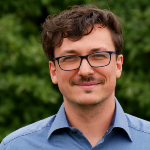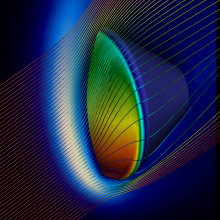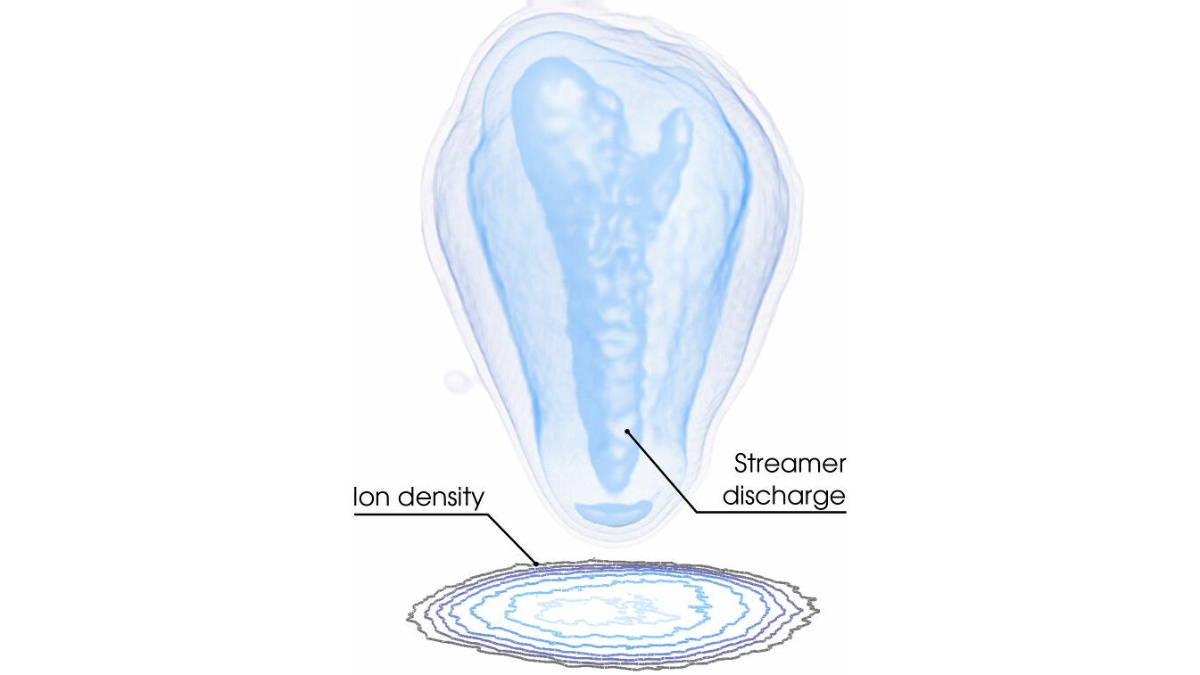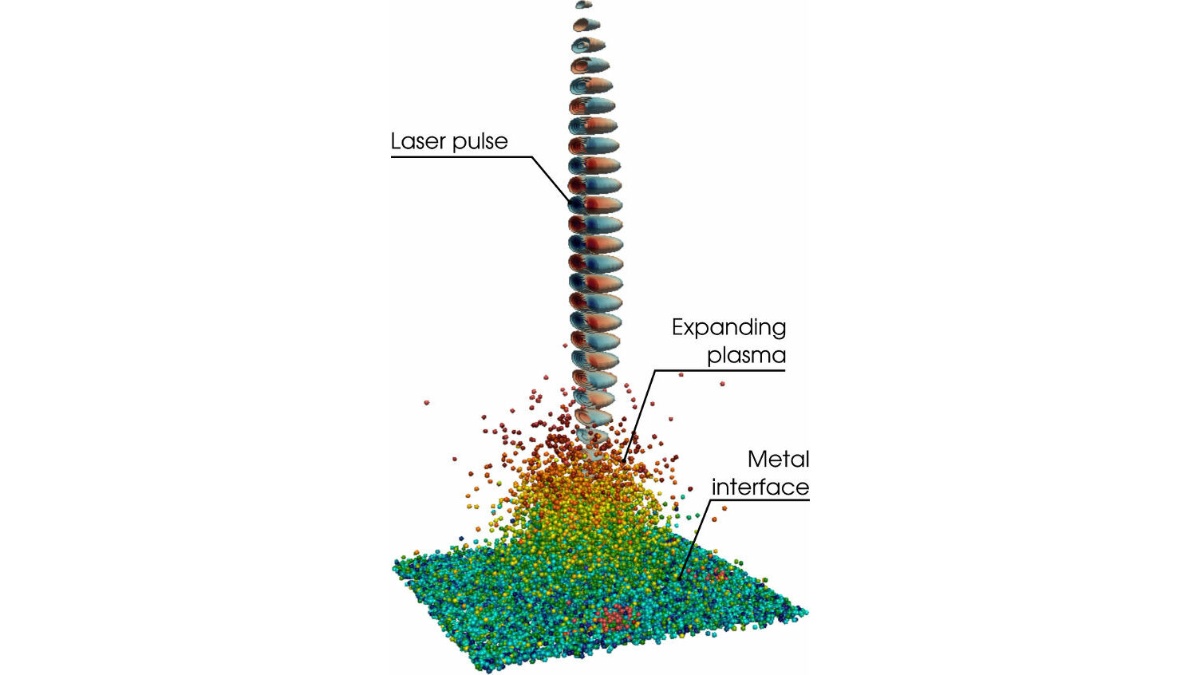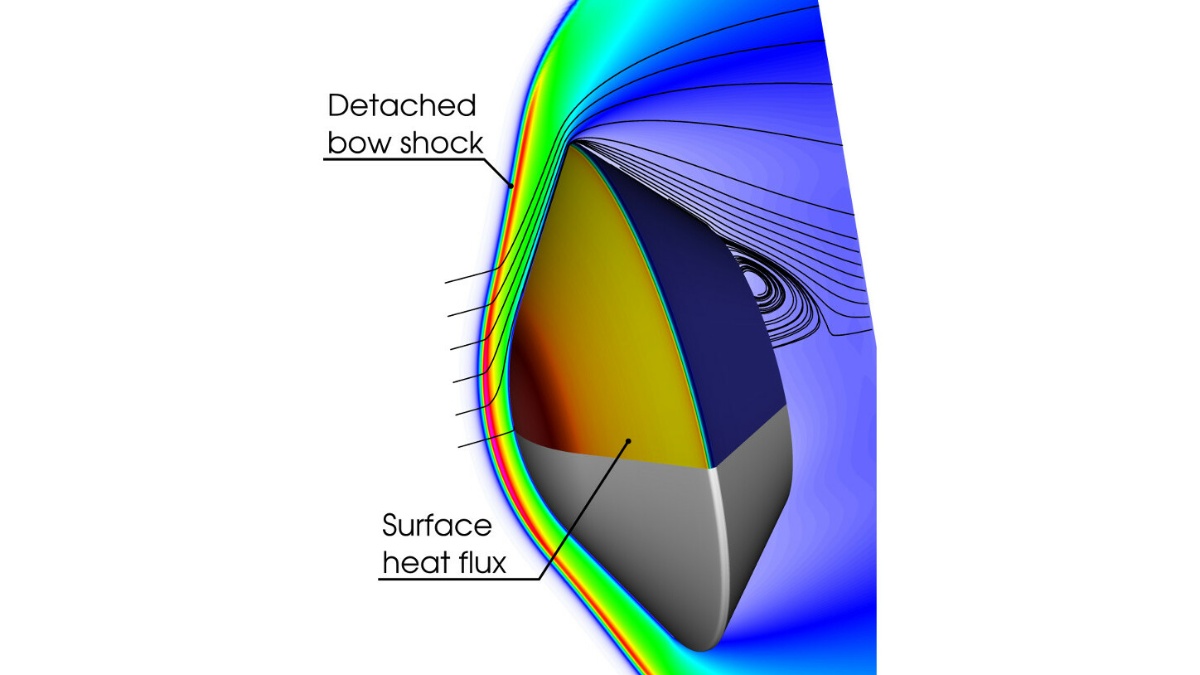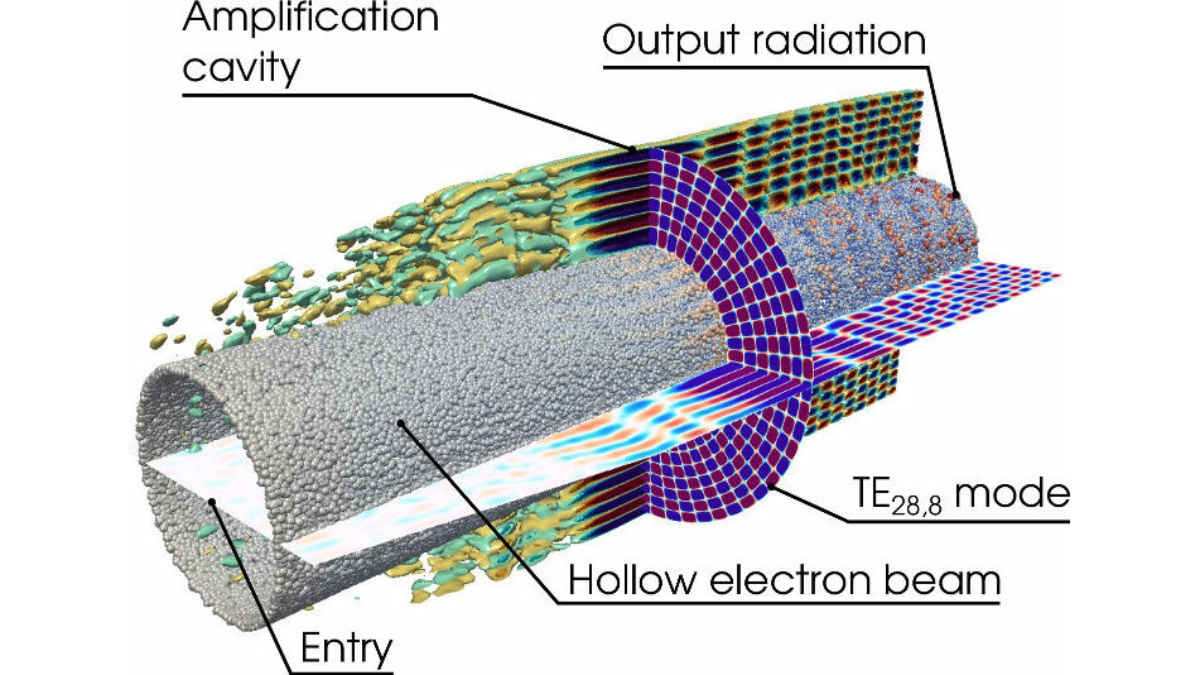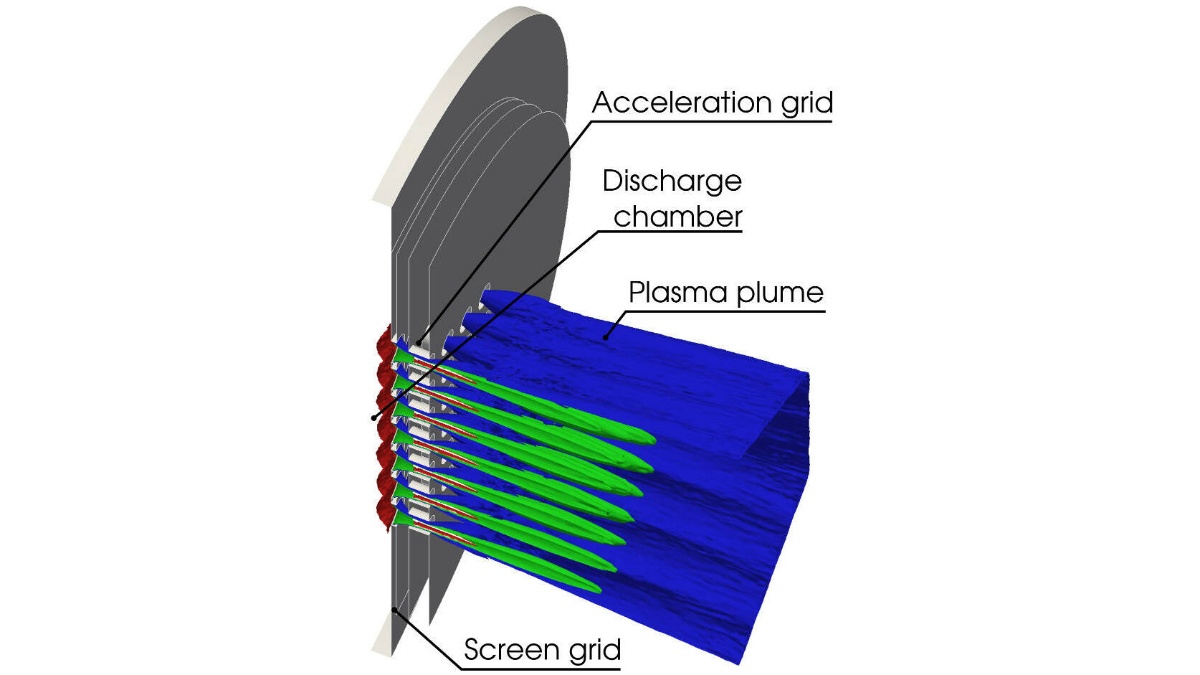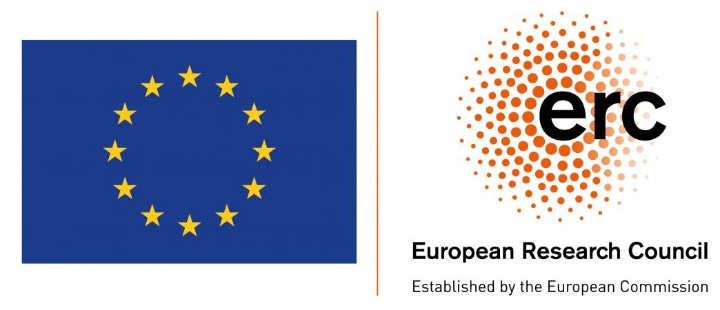Entry missions into the atmospheres of planets and those of other celestial bodies represent future goals in space travel. They can only be safely accomplished with improved knowledge of the behavior, properties, and effects of gas flows around spacecrafts. Additionally, the design of advanced space propulsion systems requires a sound knowledge of the behavior of the engine exhaust gas stream. Numerical methods enable the possibility to simulate flows, where suitable experiments are usually very limited or associated with high costs. Therefore, numerical investigation methods are gaining more importance.
One focus of the "Numerical modeling and simulation" group is modeling non-equilibrium effects in gases and plasmas. These always occur when large local differences in surrounding conditions are involved, e.g. large temperature differences. Examples related to space travel have been mentioned considering entry missions or space propulsion systems. However, understanding these effects also becomes increasingly important in other industrial sectors. The spectrum ranges from micro- and nanotechnology, including plasma-based coating processes for nanotechnology production itself, to next-generation lithography.
Within a cooperation between the Institute of Space Systems (IRS) and the Institute of Aerodynamics and Gas Dynamics (IAG), the particle code "PICLas" is being developed as a flexible simulation tool to calculate three-dimensional gas and plasma flows. Meanwhile, the company "boltzplatz" has established itself as a university spin-off, founded by former employees of the numerics departments of IRS and IAG. This ensures a direct exchange between industry and university as well as a continuously growing number of users of PICLas in either field. More information and contact details can be found at the boltzplatz homepage.
PICLas couples different field and particle solvers to provide numerically efficient solution methods in different gas and plasma regimes. Since PICLas historically started as a tool for simulating diluted gases and plasmas, its two largest components are the Particle-In-Cell (PIC) and the Direct Simulation Monte Carlo (DSMC) modules. While the PIC part models electromagnetic interactions of particles in plasmas, the DSMC part models collisions and chemical reactions. Both methods have been used for many years in a wide range of numerical applications and are constantly being developed.
Another development of PICLas deals with the numerical investigation of flows and plasmas in the context of multiscale phenomena. This includes for example extremely large density gradients as they occur in nozzle expansions. Another example are large temporal gradients of the physical effects occurring in the flows. The time scales of plasma oscillation and advection of ions, which is relevant in electric space propulsion systems, can be several orders of magnitude apart. For these purposes, different particle-continuum methods like the Bhatnagar-Gross-Krook (BGK) or the Fokker-Planck method are being coupled with PIC and DSMC. In addition, various implicit procedures are being developed to further increase the effectiveness of the implemented methods.
Furthermore, in some of the flows under investigation, radiation effects play an important role. Therefore, the working group also deals separately with the further development of radiative energy transfer solvers.
Various applications simulated with PICLas
Current projects
The objective is to develop particle-based multiscale methods for thermo-chemical non-equilibrium gas and plasma flows, which for the first time enable the simulation of a large number of high-tech applications.
DROPIT is a research training group that deals with the investigation of droplet interaction phenomena. The aim is to understand how microscale transport processes influence macroscopic flow properties.
The Collaborative Research Center (CRC) 1667 “ATLAS - Advanced Technologies of Very Low Altitude Satellites” deals with the scientific and technical challenges for the development of very low Earth orbits (VLEO, about 200 km to 450 km altitude). The Numerics Group is developing a more detailed gas-surface interaction model within ATLAS.
Numerical methods
Stochastic particle methods are the focus of the numerics group at the IRS. They often offer advantages, especially for higher-dimensional problems such as the solution of the Boltzmann equation.
The development of noise reduction methods for stochastic particle methods is of great importance for slow or low-mach flows.
During atmospheric entry, spacecraft encounter high enthalpy flow. This ionizes and excites internal degrees of freedom in atoms and molecules, causing radiation that significantly affects surface heat flux. The PICLas radiation module uses a Monte Carlo method for accurate energy transfer in complex geometries, ensuring precise heat flux predictions.
Heat shields are essential for atmospheric spacecraft entry. The choice of material is crucial for extreme conditions and weight minimization. Heterogeneous processes between gas and surface influence the heat flow. A catalytic reaction model developed in PICLas estimates this influence, as experiments are cost-intensive.
Very Low Earth Orbit (VLEO), typically defined as altitudes below 450 km, presents unique challenges and opportunities for satellite missions. One of the critical aspects of operating in VLEO is understanding gas-surface interactions, which significantly impact the design and operation of satellites.
Particle-based multiphase methods offer an efficient way to visualize non-equilibrium effects in multiphase flows.
Plasma effects play a major role in highly enthalpy flows. The Particle-In-Cell method is therefore used to simulate non-equilibrium effects in plasmas.
Plasma Kinetic Code PICLas
All models developed within the numerics group are available on GitHub in the open source code PICLas. In addition, detailed documentation can be found at piclas.readthedocs.io.
Team
Dr.-Ing. Marcel Pfeiffer
Group management, management ERC Starting Grant MEDUSA
Tel. +49 (0)711 685-60335
Mail: mpfeiffer@irs.uni-stuttgart.de
Félix Garmirian, M. Sc.
Noise reduction methods, Discrete-Velocity-Methods
Tel. +49 (0)711 685-69609
Mail: garmirianf@irs.uni-stuttgart.de
Franziska Hild, M. Sc.
Modeling of gas mixtures in non-equilibrium
Tel. +49 (0)711 685-62051
Mail: hildf@irs.uni-stuttgart.de
Simone Lauterbach, M. Sc.
Surface chemistry, method coupling, multiscale problems
Tel. +49 (0)711 685 60456
Mail: lauterbachs@irs.uni-stuttgart.de
Tobias Ott, M. Sc.
Multiscale plasma simulations, Particle-In-Cell
Tel. +49 (0)711 685-62366
Mail: ottt@irs.uni-stuttgart.de
Miklas Schütte, M. Sc.
Gas-surface interactions in VLEO
Tel. +49 (0)711 685-65860
Mail: schuettem@irs.uni-stuttgart.de
Raphael Tietz, M. Sc.
Modeling of multiphase flows in non-equilibrium
Tel. +49 (0)711 685-69674
Mail: rtietz@irs.uni-stuttgart.de
Kim-Sophie Ellenberger, M. Sc.
Modeling and simulation of plasma wind tunnel flows
Tel.
Mail: ellenbergerk@irs.uni-stuttgart.de
You can find our publications here:
Teaching
Simulation of Rarefied Gases and Plasmas
Master's Program in Aerospace Engineering
Specializations:
- B (Experimental and Numerical Simulation Methods in Aerospace Engineering)
- H (Space Flight Technology and Space Utilization)
Possible topics:
- Surface catalysis mechanisms: time of flight analysis
- Method comparison (ECSIM, HDG, FEM) with ion thruster
- Predicting plasma parameters with machine learning
We are looking for:
- Bachelor or Master students in STEM,
- interested in code development,
- able to work independently and autonomously,
- and optional: experience with Fortran
Please send applications to
Simone Lauterbach, M. Sc.
Mail: lauterbachs@irs.uni-stuttgart.de
Contact
